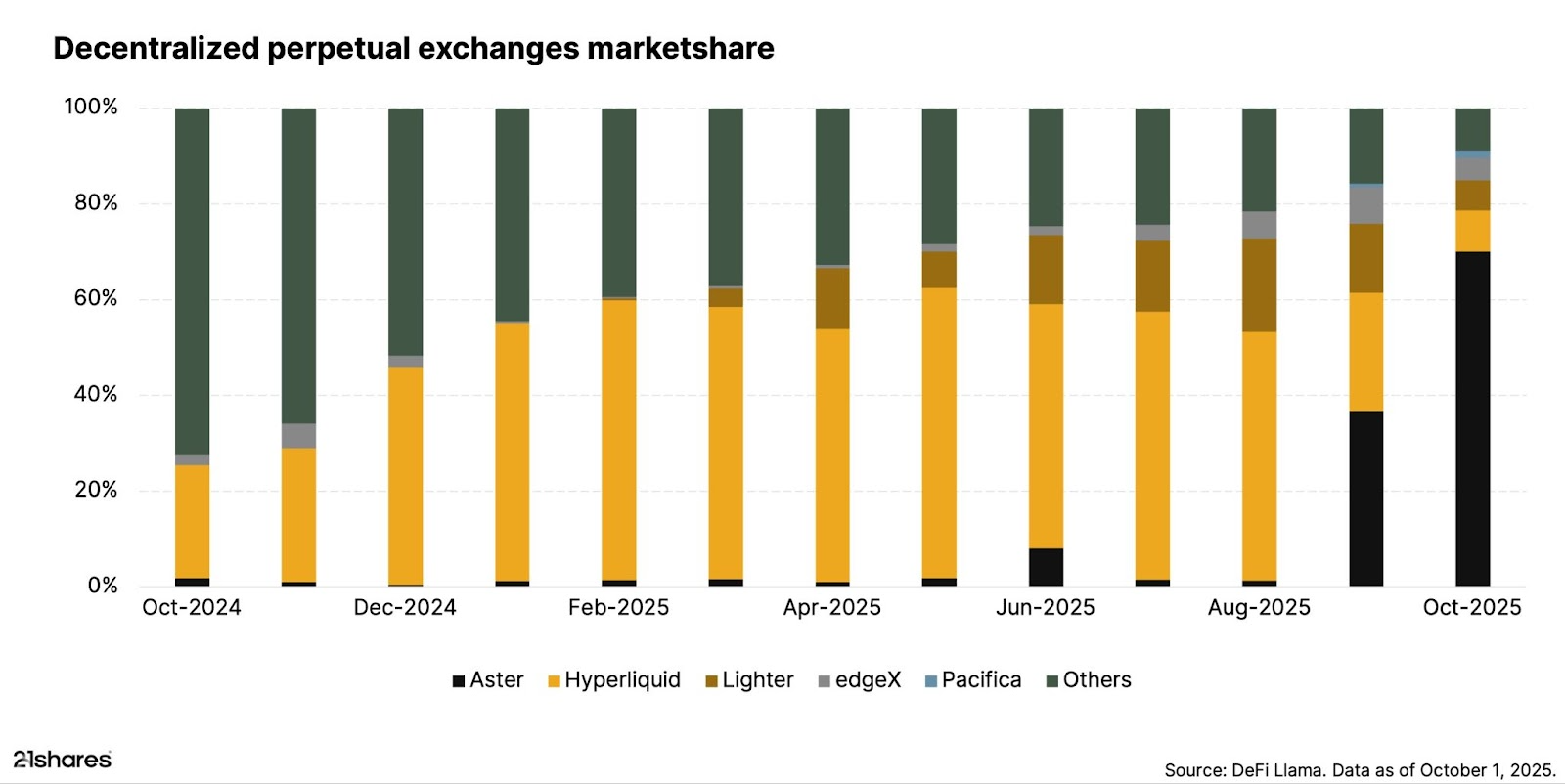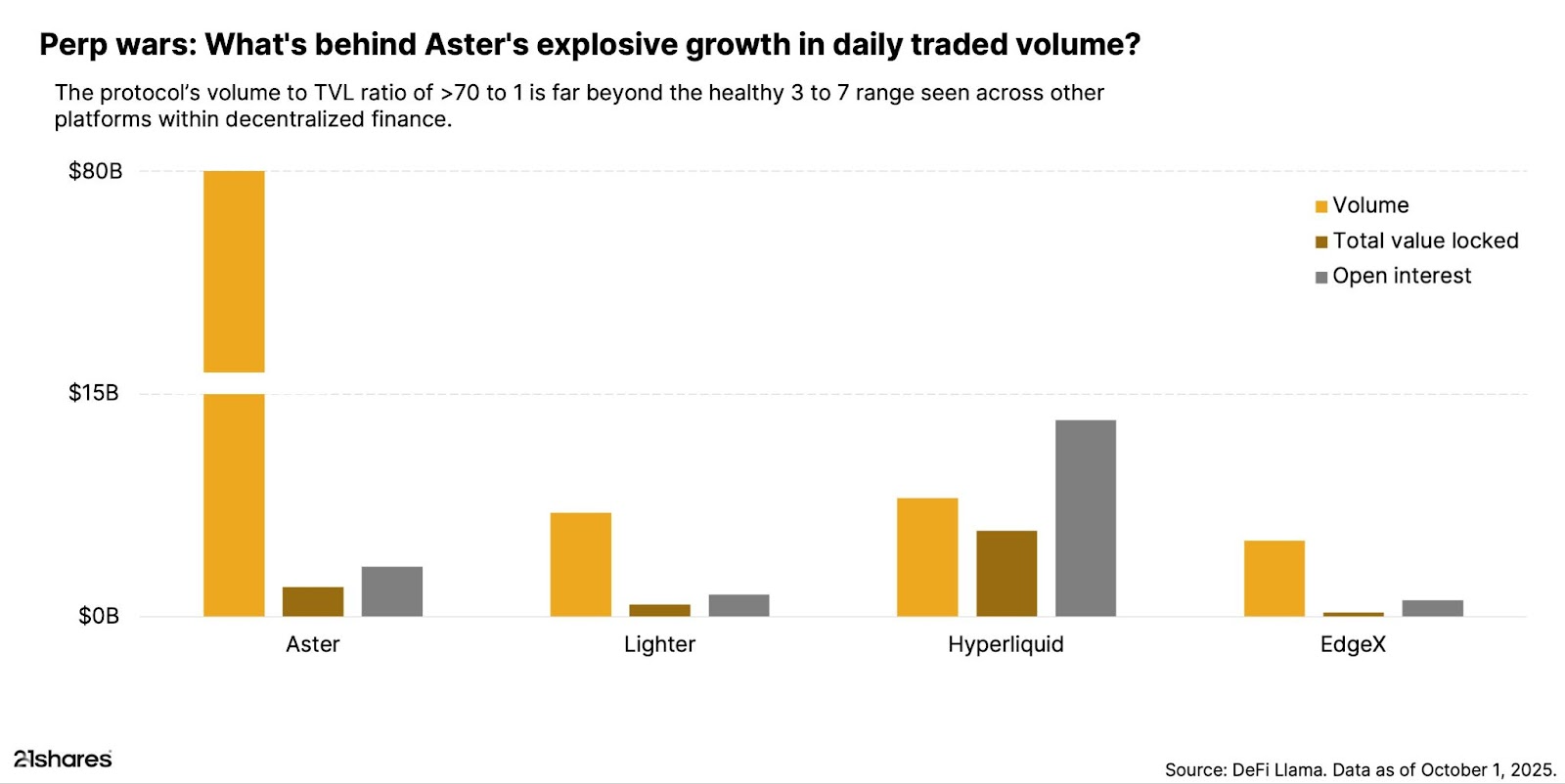The perpetual DEX wars: Hyperliquid, Aster, and Lighter in focus



Decentralized perpetual exchanges (perp DEXs) have become one of the most competitive arenas in decentralized finance (DeFi). From a few billion dollars in early 2024, daily trading volumes on perp DEXs have exceeded $100 billion by the first week of October 2025.
For much of this explosive evolution over the last 12 months, Hyperliquid was the undisputed leader, commanding around 70% of market share. But by October 2025, its dominance had declined as Aster and Lighter entered the scene. Today, the perpetual derivatives market is a three-way race, with each platform offering distinct technical and product innovations that reshape how traders interact with decentralized finance.

Market Shifts: From Dominance to Competition
Perp DEXs have started in September 2025 with a major shift in dynamics. Hyperliquid’s share slipped to about 10%, Aster dominated with nearly 70%, and Lighter, still in private beta but newly live on mainnet as of October 2, captured 15%.
- Hyperliquid sustains daily volumes of $10–15 billion, signaling consistent though moderated activity. Still, its open interest remains more than four times greater than Aster’s as it offers $13.5 billion vs $3 billion for Aster.
- Aster surged dramatically, leaping from around $1 billion in late September to more than $70 billion by the end of the month, making it the clear market leader by raw trading volume.
- Lighter, which remains invite-only but launched its mainnet on October 2, processes roughly $8 billion each day, highlighting strong momentum before a wider rollout.
This shift underscores how liquidity and user adoption are no longer concentrated in a single venue. Instead, innovation is fragmenting the market into specialized competitors. Within this landscape, Aster has emerged as the apparent leader, but questions linger over how much of its growth is truly organic.
The Aster dilemma: Organic expansion or rewards-fueled growth?
Despite Aster’s remarkable rise, onchain data suggests its volumes may be artificially inflated. The protocol’s volume to TVL ratio of >70 to 1 is far beyond the healthy 3 to 7 range seen across other DeFi platforms, signaling possible wash trading.

This concern is reinforced by its sudden 10 times spike in daily volume within a single week, an adoption curve difficult to reconcile with organic growth.

Aster’s points-based rewards system raises further concerns, as it incentivizes repetitive self-trading that inflates reported volumes and creates the impression of strong growth. Taken together, these mechanisms suggest an engineered growth play aimed at enhancing optics, attracting liquidity, and consolidating market leadership.
With this context established, it is worth diving deeper into the three protocols to see how each differentiates itself.
Hyperliquid: The performance pioneer
Technical superiority
Hyperliquid operates on a custom Layer-1 chain featuring HyperCore - Central Limit Order Book (CLOB) and HyperEVM (smart contracts). Its consensus system, HyperBFT, enables sub-second finality (~0.2s) and throughput of up to 200,000 orders per second, a performance rivaling top centralized exchanges.
Liquidity depth and market Tools
By choosing a fully onchain (CLOB) over automated market makers (AMMs), Hyperliquid offers tighter spreads, superior price discovery, and institutional-grade execution. Its Hyperliquidity Provider (HLP) vault allows users to contribute to market-making, earning around 6-8% APY, with peak liquidity exceeding $500 million.
Tokenomics and sustainability
Hyperliquid generated over $800 million in annualized revenue in 2025. Most of these fees are used for HYPE token buybacks, which have resulted in buying back more than $715 million in HYPE, creating deflationary pressure. With no VC allocations and a community-first distribution, Hyperliquid has fostered deep user loyalty alongside a multi-billion-dollar token market cap.
Strengths: unmatched throughput, deep liquidity, CEX-like user-intuitive interface and sustainable revenue model.
USP: The only DEX that fully replicates a CEX’s speed and reliability on-chain.
Aster: The multi-chain disruptor
Architecture and accessibility
Aster prioritizes multi-chain deployment, operating across BNB Chain, Ethereum, Solana, and Arbitrum. This design eliminates bridging complexity and appeals to users already active in different ecosystems.
Aster’s dual-mode trading system adds flexibility:
- Simple Mode offers up to 1,001x leverage with ALP pool liquidity.
- Pro Mode features a CLOB interface with advanced order types and MEV protection.
Product innovations
Aster stands out by offering stock perpetuals, enabling crypto-settled trading of equities like Apple and Tesla with up to 50x leverage. This bridges crypto with traditional markets in a way few competitors attempt.
It also introduced hidden orders to combat front-running, and yield-bearing collateral (e.g., asBNB, USDF) so margin deposits can simultaneously generate yield.
Market impact
Aster’s merger with APX Finance was explosive, with daily volumes briefly surpassing Hyperliquid’s and a token surge exceeding 2,000%. Its growth has been amplified by endorsements from Binance leadership and deep integration with the BNB ecosystem.
Strengths: stock perps, MEV-protected trading, broad multi-chain reach.
USP: First perp DEX to offer high leverage for crypto and equities in a single platform.
Lighter: The zero-knowledge pioneer
Cryptographic guarantees
Lighter takes a trust-first approach, using a custom zk-rollup on Arbitrum. Every trade, liquidation, and settlement is verified by zero-knowledge proofs, ensuring cryptographic guarantees of fairness that no centralized or decentralized competitor can currently match.
Zero-fee advantage
Lighter has adopted a bold zero-fee model for retail traders, fueling an average of $3 billion in daily volume by mid-September, to now exceeding $7 billion despite being invite-only. Its Lighter Liquidity Pool (LLP), its community-based market-making vault that supports trading on Lighter’s order book, has generated an average of 60% APY since early 2025, combining high yields with liquidity provision.
Team and backing
Founded by former Citadel engineers and backed by firms like a16z, Lighter combines traditional finance pedigree with cutting-edge cryptography. Its roadmap includes LLP margin utility, letting users trade and earn yield on the same capital, thus enhancing efficiency compared to rivals.
Strengths: zk-proof fairness, zero trading fees, institutional backing.
USP: Only DEX offering mathematically verifiable execution.
Comparative Analysis
The competition is not simply about market share; it’s about competing philosophies:
- Hyperliquid proves DeFi can match centralized exchanges in speed and liquidity.
- Aster pushes boundaries with multi-chain support and stock perps.
- Lighter redefines trust through zk-verification and zero fees.
Together, they show how perp DEXs are no longer a niche but a maturing industry that could rival CEXs for dominance in derivatives trading.
Risks and Outlook
- Regulation: High leverage (Aster’s 1,001x) and lack of KYC could invite scrutiny.
- Sustainability: Incentive-driven models (Aster) or zero-fee approaches (Lighter) must prove long-term viability.
- Liquidity: Early growth can fade if incentives dry up or beta restrictions remain.
Despite these risks, the perp DEX sector has enormous upside. With only ~10% of CEX perp volumes currently captured, the growth runway remains vast.
Conclusion
The perpetual DEX wars highlight three visions of DeFi’s future:
- Hyperliquid: maximum speed and scalability.
- Aster: accessibility and cross-asset innovation.
- Lighter: transparency and fairness via zk-proofs.
All in all, it is unlikely that a single winner will emerge in the perpetual futures DEX market. Instead, platforms are carving out niches based on the needs of different trader segments. Hyperliquid has become the venue of choice for professionals who value speed, depth, and reliability, while also appealing to retail users who want a smooth and intuitive interface. Aster attracts retail traders seeking ultra-high leverage as well as crossover users looking for asset variety and flexible entry points. Lighter positions itself as the fair and cost-efficient alternative, appealing to those who prioritize transparency and low trading costs. In this environment, users themselves are the ultimate beneficiaries, gaining access to faster, fairer and more diverse derivatives markets than ever before.
The broader market dynamics show how quickly the competitive landscape is shifting. In the early period from 2022 to 2023, dominance was relatively stable, with dYdX often holding more than half the market for almost 7 months. From 2024 onward, the pace of change accelerated sharply, with average leadership tenures measured in only a few weeks. While Hyperliquid has managed to maintain share over longer stretches, Aster’s rapid surge to majority share in 2025 highlighted how incentives can drive sudden swings in market leadership, although, of course, it's arguably inorganic. These shifts reflect how sensitive traders are to liquidity programs, rewards and rebates, as well as execution quality, risk management, and user experience. The result is a market defined by constant churn, where no position is secure and sustained leadership requires continuous innovation and reinforcement.
Comparison Table: Hyperliquid vs Aster vs Lighter

This report has been prepared and issued by 21Shares AG for publication globally. All information used in the publication of this report has been compiled from publicly available sources that are believed to be reliable, however, we do not guarantee the accuracy or completeness of this report. Crypto asset trading involves a high degree of risk. The crypto asset market is new to many and unproven and may have the potential not to grow as expected.Currently, there is relatively small use of crypto assets in the retail and commercial marketplace in comparison to relatively large use by speculators, thus contributing to price volatility that could adversely affect an investment in crypto assets. In order to participate in the trading of crypto assets, you should be capable of evaluating the merits and risks of the investment and be able to bear the economic risk of losing your entire investment.Nothing herein does or should be considered as an offer to buy or sell or solicitation to buy or invest in crypto assets or derivatives. This report is provided for information and research purposes only and should not be construed or presented as an offer or solicitation for any investment. The information provided does not constitute a prospectus or any offering and does not contain or constitute an offer to sell or solicit an offer to invest in any jurisdiction. The crypto assets or derivatives and/or any services contained or referred to herein may not be suitable for you and it is recommended that you consult an independent advisor. Nothing herein constitutes investment, legal, accounting or tax advice, or a representation that any investment or strategy is suitable or appropriate to your individual circumstances or otherwise constitutes a personal recommendation. Neither 21Shares AG nor any of its affiliates accept liability for loss arising from the use of the material presented or discussed herein.Readers are cautioned that any forward-looking statements are not guarantees of future performance and involve risks and uncertainties and that actual results may differ materially from those in the forward-looking statements as a result of various factors.This report may contain or refer to material that is not directed to, or intended for distribution to or use by, any person or entity who is a citizen or resident of or located in any locality, state, country or other jurisdiction where such distribution, publication, availability or use would be contrary to law or regulation or which would subject 21Shares AG or any of its affiliates to any registration, affiliation, approval or licensing requirement within such jurisdiction.





